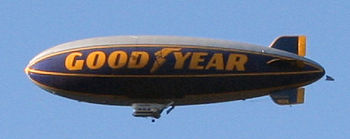Non-rigid airship: Difference between revisions
imported>Dan Nachbar m (bolded title) |
imported>Dan Nachbar m (added image) |
||
| Line 1: | Line 1: | ||
[[Image:Goodyear-blimp.jpg|right|thumb|350px| | |||
{{#ifexist:Template:Goodyear-blimp.jpg/credit|{{Goodyear-blimp.jpg/credit}}<br/>|}}The Goodyear Blimp]] | |||
'''Non-rigid airships''', often called "blimps" are a type of [[buoyant]] [[aircraft]] that can be propelled and steered that does not use a skeletal frame to hold the shape when it is under [[aerodynamics|aerodynamic]] loads. In particular, the [[fabric]] of the envelope is | '''Non-rigid airships''', often called "blimps" are a type of [[buoyant]] [[aircraft]] that can be propelled and steered that does not use a skeletal frame to hold the shape when it is under [[aerodynamics|aerodynamic]] loads. In particular, the [[fabric]] of the envelope is | ||
part of the structural system. | part of the structural system. | ||
Revision as of 16:37, 17 November 2007
Non-rigid airships, often called "blimps" are a type of buoyant aircraft that can be propelled and steered that does not use a skeletal frame to hold the shape when it is under aerodynamic loads. In particular, the fabric of the envelope is part of the structural system.
In contrast, rigid airships use a frame, typically made of metal, to hold the shape of the craft. On a rigid aircraft, the fabric is typically a covering and provides no structural support.
The most famous blimps are those operated by the Goodyear Tire and Rubber company. These "Goodyear blimps" have been in use since the 1930's.
Blimps were used with great success during World War II as anti-submarine scouting platforms.
Today, blimps are used primarily as advertising platforms. However they are used sometimes by police for public safety.
The vast majority of blimps are filled with Helium which provides their buoyancy.
Blimps that use hot air rather than Helium are called thermal airships.
